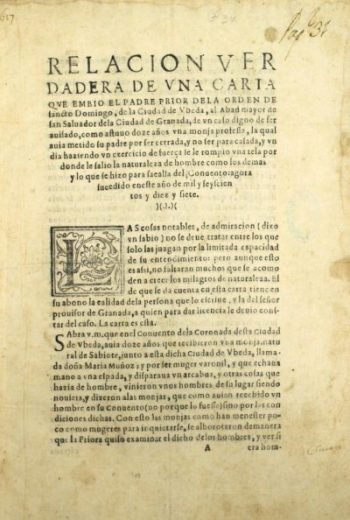
Libraries
Libraries
Relación verdadera de una carta que envió el padre prior de la orden de Santo Domingo, de la ciudad de Úbeda, al Abad mayor de San Salvador de la ciudad de Granada
In 1617, the first printing press in South America published this interesting document that narrates an event that took place in Ubeda, Spain, based on an original that had been printed in Seville. The author was Fray Agustín de Torres, who describes the case of the nun María Muñoz. The facts surrounding this case of genetic disorder have the peculiarity of having a great amount of details that allow us to explore possible medical diagnoses. It should be noted that medical issues of sexual variants were not alien to the societies of the centuries before or after the 17th century.
The ecclesiastical and administrative establishment was no stranger to cases of hermaphroditism. Although it could be said that the Catholic Church was an actor in the sex assignment of someone like María Muñoz, I think we should be aware of the historical and medical context of the time. When an individual is born with a sexual ambiguity we can see that there is a certain curiosity among the population that causes the news to spread quickly, as in this case. Despite this, it is important to highlight the care with which those involved dealt with the issue as María Muñoz made this transition between her cloistered life and her future life with her father.
Today, hermaphroditism can be classified as “true hermaphroditism” – an individual with one ovary and one testicle; or as “male or female pseudohermaphroditism” – the individual shows a male genetic and gonadal sex, although the external genitalia are female. In our context, laboratory tests – genetic tests, hormone profile, ultrasound, etc. – are needed to enable us to make an accurate medical diagnosis. – are needed to enable us to make an accurate medical diagnosis. Despite this, the document is highly descriptive and could even be compared to cases of “male pseudohermaphroditism” or syndromes that are related to a disorder of sexual development – such as Swyer’s syndrome or others. This makes the source an essential tool for those who want to explore how certain diseases were treated during the 17th century.
The present documentation allows us to explore different points that connect medicine, genetics, religion, society and identity. It also allows us to see how quickly news was transmitted within the geographically vast Spanish Empire. Finally, sources like this one force us to explore multidisciplinary work in order to take advantage of all the information that a document like this can provide.
Enrique Urteaga
Proyecto Estudios Indianos

